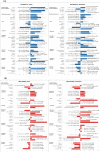International incidence and mortality trends of liver cancer: a global profile
- PMID: 28361988
- PMCID: PMC5374459
- DOI: 10.1038/srep45846
International incidence and mortality trends of liver cancer: a global profile
Abstract
We examined the global incidence and mortality rates of liver cancer, and evaluated the association between incidence/mortality and socioeconomic development (Human Development Index [HDI] and Gross Domestic Product [GDP]) using linear regression analysis. The average annual percent change (AAPC) of the trends was evaluated from join-point regression analysis. The global incidence of liver cancer varied widely by nine-fold, and was negatively correlated with HDI (men: r = -0.232, p = 0.003; women: r = -0.369, p < 0.001) and GDP per capita (men: r = -0.164, p = 0.036; women: r = -0.212, p = 0.007). Its mortality showed a similarly negative correlation with both indices. The greatest incidence rise in men was observed in Poland (AAPC = 17.5, 95% C.I. = 5.6, 30.9) and Brazil (AAPC = 13.2, 95% C.I. = 5.9, 21.0), whereas Germany (AAPC = 6.6, 95% C.I = 2.0, 11.5) and Norway (AAPC = 6.5, 95% C.I. = 3.2, 10.0) had the greatest increase in women. The mortality rates paralleled the incidence rates in most countries. For mortality, Malta (AAPC = 11.5, 95% C.I. = 3.9, 19.8), Australia (AAPC = 6.8, 95% C.I. = 2.2, 11.5) and Norway (APCC = 5.6, 95% C.I. = 2.8, 8.5) reported the biggest increase among men; whilst Australia (AAPC = 13.4, 95% C.I. = 7.8, 19.4) and Singapore (AAPC = 7.7, 95% C.I. = 4.1, 11.5) showed the most prominent rise among women. These epidemiological data identified countries with potentially increasing trends of liver cancer for preventive actions.
Conflict of interest statement
The authors declare no competing financial interests.
Figures



References
-
- Ferlay J. et al.. GLOBOCAN 2012 v1.0, Cancer Incidence and Mortality Worldwide. IARC Cancer Base No. 11. Lyon, France: International Agency for Research on Cancer (2013).
-
- Soerjomataram I. et al.. Global burden of cancer in 2008: a systematic analysis of disability-adjusted life-years in 12 world regions. Lancet 380, 1840–1850 (2012). - PubMed
-
- Center M. M. & Jemal A. International trends in liver cancer incidence rates. Cancer Epidemiol. Biomarkers Prev. 20, 2362–2368 (2011). - PubMed
-
- Parkin D. M. & Bray F. International patterns of cancer incidence and mortality in Cancer epidemiology and prevention. 3rd ed (ed. Schottenfeld D., Fraumeni J. F. Jr.) 101–138 (New York: Oxford University Press, 2006).
MeSH terms
LinkOut - more resources
Full Text Sources
Other Literature Sources
Medical

